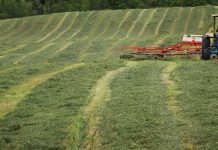Alfalfa is an important forage crop in the diet of dairy cows and every dairy producer wants to feed high quality forage. Nothing is more stressful than to see a beautiful alfalfa crop decline in quality with each rainstorm.
Rain is one factor that no one can control and often causes a great deal of frustration for anyone wanting to make high quality hay. Unfortunately, we do not have the luxury of turning the water “off and on” like many producers in the western United States.
Let’s take a look at the impacts of rainfall on forage crops and discuss management strategies you can use to minimize losses.
Huge impact. Rainfall that occurs between the time the forage is cut and harvested causes both yield and quality losses that result in reduced value. Some of these losses include reduced energy, protein losses, leaf shattering and color loss.
Effects on yield. Several university research studies have measured the effects of rainfall on cut alfalfa. A Wisconsin study showed dry matter losses of 22 percent when alfalfa received 1 inch of rain after one day of curing. Similar hay without rain damage lost only 6.3 percent of the potential yield.
Losses appear to be greatest after partial drying of the forage has occurred.
In this same Wisconsin study, rainfall of 1.6 inches over several days resulted in a 44 percent loss in dry matter.
In Michigan, several studies have been conducted that examine the effects of rainfall on field-cured alfalfa. Varying amounts of rainfall were studied and resulted in dry matter losses ranging from 4 percent to 34 percent. The highest losses occurred when rainfall amounts were spread over several days.
In the Michigan studies, overall dry matter losses were lower than those found in Wisconsin although rainfall amounts in some cases were nearly 2 inches.
After the rains. Three factors are involved that reduce yield. These include leaching, respiration and leaf loss.
Many of the highly digestible parts of the plant are water-soluble and leach out during a rain event. Although respiration is a natural function of the plant and typically results in losses of about 3 percent to 4 percent of the potential dry matter harvest, rainfall can cause respiration to be prolonged or begin again in situations where the forage is below 30 percent moisture.
There is some disagreement about the amount of leaf loss that occurs in cut alfalfa, as a direct result of rainfall. Studies in Ontario, Wisconsin and Michigan found losses as low as 0.5 percent to as high as 20 percent based on varying amounts of rainfall.
Rainfall intensity. Research is conclusive in this area. Given the same amount of rainfall, a low intensity rain will result in more leaching of soluble compounds than a high intensity rain. As forage moisture declines, it is more prone to dry matter losses from rain.
What about quality? Most rainfall studies agree that wetting of field-cured alfalfa has little impact on crude protein concentration. In fact, it is common to see relatively high protein values in comparison to fiber concentrations.
However, because rain leaches soluble carbohydrates, structural fibers (ADF and NDF) comprise a greater percent of the forage dry matter.
Depending on a number of factors, the digestibility of rained-on hay may decline from 6 percent to 40 percent.
Rain in forecast. Here’s the big question: My hay is ready to cut, but rain is in the forecast. Do I cut?
Every hay producer has asked this question more than once. Because many factors impact forage quality as a result of rainfall, there is no easy answer. However, based on research and applied management practices, it is possible to categorize factors that increase the risk of cutting hay when the weather forecast is less than perfect. These are listed in the adjacent table.
The busy haymaking season is fast approaching and I hope this year you have a terrific harvest without many weather complications. Have a safe spring.
(The author is an agricultural extension agent in Tuscarawas County. Questions or comments can be sent in care of Farm and Dairy, P.O. Box 38, Salem, OH 44460. This article was adapted from the Forager Newsletter by Mike Rankin and Daniel Undersander, University of Wisconsin Extension.)












